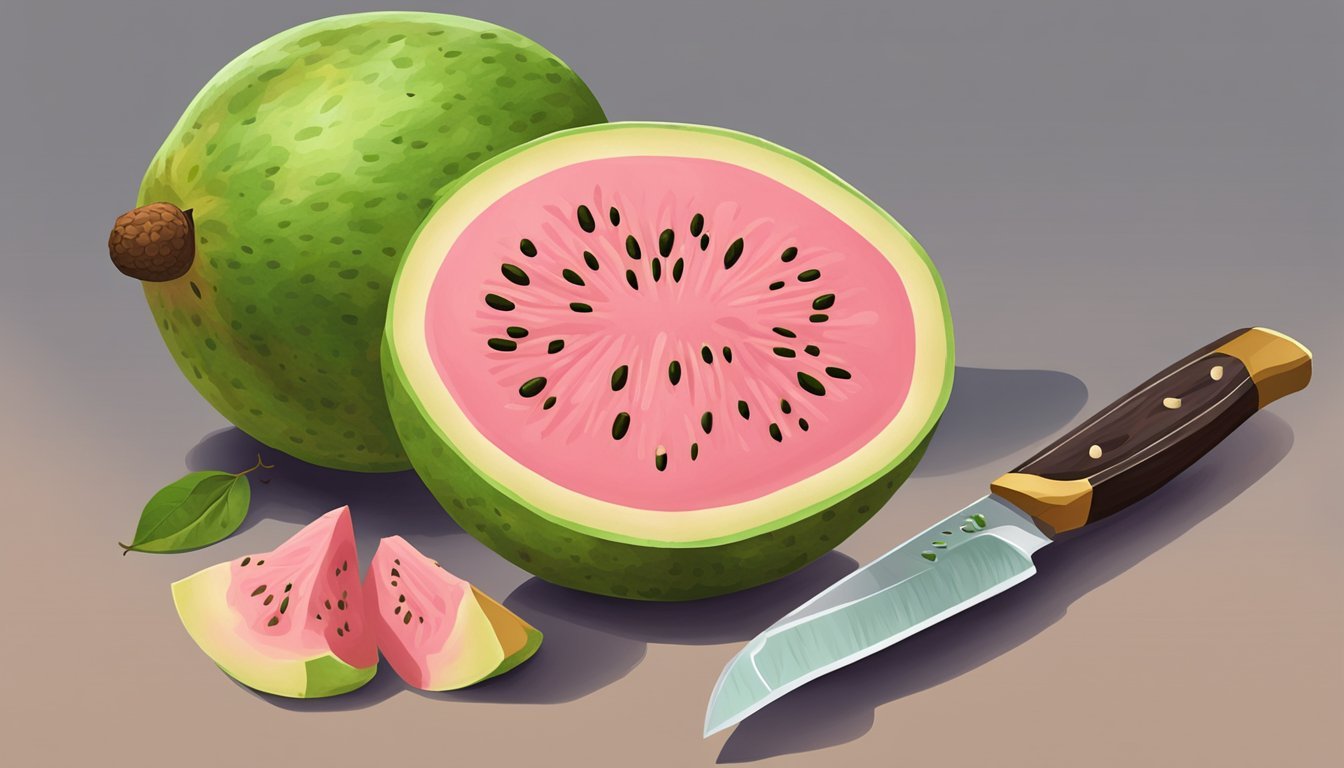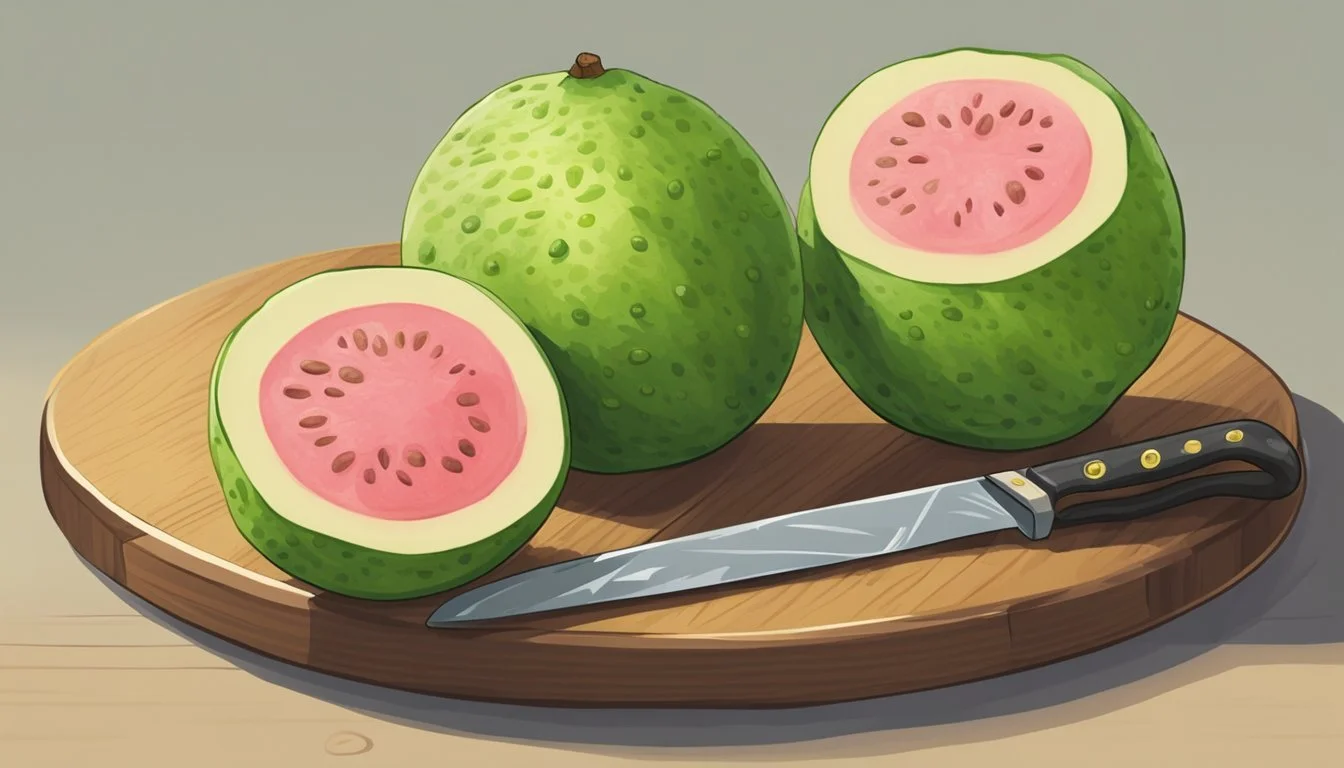How to Eat a Guava:
Simple Steps for Enjoying This Tropical Fruit
Guava is a tropical fruit treasured around the world for its unique flavor and nutritional benefits. Originating from Mexico, Central America, the Caribbean, and South America, the fruit has made its way into various cuisines, offering both health benefits and a burst of flavor. With its yellow or light green skin and pink or white flesh, the guava can be enjoyed in different ways depending on personal preferences. Eating guava is not just about indulging in its sweet and musky flavor; it's also reaping the benefits of its high vitamin C content, even more so than what’s found in an entire orange.
When it comes to eating guava, there's no one right method. The fruit can be consumed whole, with both the rind and the seeds being edible. Some opt for cutting the fruit in half and enjoying it with a spoon, scooping out the flavorful flesh. Others might prefer to slice it into smaller pieces, which can make it easier to eat and remove the rind if desired. The texture of a ripe guava should be soft and yielding to a gentle squeeze, with a fragrance to indicate its readiness to be eaten. Care should be taken to wash the guava thoroughly before consuming to remove any residues from its surface.
Whether eaten on its own, tossed in fruit salads, or used to flavor dishes and drinks, guava offers a versatile and nutritional eating experience. Its tropical taste can be a delightful addition to a balanced diet, and its ease of preparation makes it a convenient snack or ingredient. By understanding the simple steps to prepare and eat guava, one can fully enjoy all the qualities this fruit has to offer.
Understanding Guava
Guavas are a popular tropical fruit enjoyed for their unique flavor and nutritional benefits. They offer a blend of taste and health, making them a favorable addition to a diverse diet.
Origin and Varieties
Guavas originated in regions that span Mexico, Central America, the Caribbean, and South America. Over time, their cultivation has spread to many tropical and subtropical areas globally, including India. There are several common varieties of guava, each with distinct characteristics:
Apple Guava (Psidium guajava): Known for its green to yellow skin and white to pink flesh.
Red Guava: Valued for its deep red flesh and pronounced sweetness.
Lemon Guava (Psidium cattleianum): Smaller in size, with a lemony flavor.
Tropical White: Creamy flesh and more mildly sweet than the red variety.
Tropical Yellow: This is a yellow-skinned guava with white flesh and a flavor reminiscent of a strawberry.
Strawberry Guava (Psidium littorale): Resembles a strawberry in flavor with its red skin and white flesh.
Nutritional Profile
Guavas are a nutrient-dense fruit boasting an impressive range of vitamins and minerals. A few key nutrients found in guava include:
Vitamin C: The skin of guava contains more of this vitamin than an entire orange.
Dietary Fiber: Prominent for its high fiber content, aiding in digestive health.
Potassium: Crucial for maintaining electrolyte balance and heart function.
Antioxidants: Guavas are rich in antioxidants, which are important for preventing cellular damage.
These nutrients play a significant role in the many health benefits associated with guavas, such as enhancing immune function and potentially reducing the risk of certain diseases.
Physical Characteristics
The physical attributes of guavas vary between the varieties but share some commonalities. Typically, guavas have a rounded shape and a size that can range from that of a small lemon to that of a large apple. The skin can be yellow, light green, or even red, and has a texture that ranges from soft to slightly rough. The flesh can be white, pink, or deep red, depending on the variety, and contains tiny, edible seeds. When ripe, guavas exude a sweet, musky aroma, signaling their readiness to be eaten. The flavor is often described as a cross between a pear and a strawberry, and the fruit can be enjoyed raw or used to prepare guava juice, which is both refreshing and sweet.
Preparation of Guava
In order to enjoy a guava at its best, one must know how to select, wash, ripen, and serve this tropical fruit appropriately. Correct preparation enhances the eating experience and ensures the guava's nutritional benefits are preserved.
Selecting and Picking
When selecting guavas at the grocery store, one should look for fruit that gives slightly to a gentle squeeze, an indicator of ripeness. The skin should be free from bruises and blemishes. Ripe guavas will also emit a sweet, musky aroma that suggests they are ready to eat.
Washing and Cutting
Guavas require a good rinse under cold water to remove any surface bacteria. Pat them dry with paper towels before proceeding to cut them. Place the guava on a cutting board and use a serrated knife to slice it in half, revealing the flesh that can range from pink to white.
Ripening Techniques
If a guava is not quite ripe when purchased, one can leave it on the counter to ripen naturally. To expedite ripening, place the guava in a paper bag with a banana or apple. However, avoid storing unripe guavas in the refrigerator, as this can halt the ripening process.
Peeling and Serving
While guava skin is edible, some may prefer to peel it before consumption, especially if the guava's skin is rough or blemished. To serve, cut the guava into slices or wedges after peeling. The seeds of the guava are also edible, but they can be removed if desired.
Consumption Methods
Exploring the versatile ways guava can be consumed, from its raw state to various culinary creations, offers an insight into the diverse flavors and textures this fruit presents.
Eating Raw
Guavas are fully edible when raw, including the rind and seeds. To consume, one simply needs to rinse the fruit with cold water, pat it dry, and slice it open. The raw flesh can be enjoyed as a snack, offering a sweet and slightly tart taste, while the seeds provide a crunchy texture.
Guava in Recipes
Incorporating guava into recipes can add a unique flavor to desserts like pies and cakes. The fruit is also suitable for making smoothies, jams, and jellies. Its tropical taste complements other ingredients in salads and can be the base for experimentations with marmalades and guava paste in sweet or savory dishes.
Flavor Pairings and Enhancements
The fruit pairs well with a variety of flavors. Lemon or lime can augment the guava's natural acidity. Combining guava with strawberry, pear, or apple in a fruit salad brings out its sweetness. Enhance savory dishes with guava by adding it to meat glazes or sauces. A pinch of salt or sugar can also heighten the guava's rich taste.
Guava-Based Products
Guava is often processed into various products like juice, jams, preserves, and syrup. Guava jam is a common spread for breads, and marmalades can make a delectable filling for pastries. For a refreshing twist, try adding guava syrup to cocktails or pairing guava paste with Mexican cream for a delectable dessert. Additionally, guava can be transformed into candies and berries for a tropical, sweet treat.
Health and Dietary Considerations
When considering the incorporation of guava into one's diet, it is beneficial to examine both the health advantages it offers and any potential dietary concerns. This tropical fruit is not only rich in nutrients but also has specific attributes that may affect individuals with certain dietary restrictions.
Benefits to Diet
Guavas are an excellent source of dietary fiber, which is crucial for healthy digestion. They contribute to a balanced diet by providing a high volume of nutrients with relatively few calories. Here are some specific nutritional benefits of guava:
Antioxidants: Guavas contain high levels of antioxidants, which can help reduce oxidative stress and may lower the risk of chronic diseases.
Vitamins: They are especially rich in vitamin C, with the rind alone offering more vitamin C than the flesh of an orange.
Blood Pressure: Incorporating guava into one's diet may aid in managing blood pressure, as studies have observed a decrease in blood pressure following guava consumption.
Fiber: With a high fiber content, guava can assist in maintaining healthy blood sugar levels and promote satiety, which can be helpful for weight management.
Nutrition: Guava provides essential nutrients such as vitamin A, potassium, and magnesium.
Potential Allergies and Concerns
While guava is a healthful addition to many diets, it is important to consider allergies and individual dietary restrictions:
Allergies: Some people may have allergic reactions to guava. Symptoms can range from mild to severe and include itching, hives, or difficulty breathing.
Dietary Restrictions: For those with specific health conditions, such as diabetes, it is crucial to consume guava in moderation due to its natural sugar content.
By recognizing both the benefits and possible concerns, individuals can make informed decisions about including guava in their diets.
Storing and Preserving Guava
Proper storage methods for guava can significantly extend its shelf life, whether one plans to consume the fruit as a snack or use it for making jams, jellies, and other preserves. Familiarity with both short-term and long-term preservation techniques is essential for maintaining the fruit's freshness and flavor.
Short-Term Storage
For ripe guavas that one intends to eat within a few days, short-term storage requires just a few simple steps. After picking or purchasing ripe guavas, they should be:
Cleaned: Gently wash the fruit under cool water.
Dried: Pat them dry with a towel to remove excess moisture.
Stored: Place the guavas in the refrigerator, preferably in the crisper drawer, which provides an optimal environment for maintaining freshness.
Ripe guavas typically last for about five days in the refrigerator before succumbing to spoilage.
Long-Term Preservation
When preserving guavas for future use, they can be processed into various forms such as guava paste, jellies, or marmalades. These products can extend the enjoyment of the fruit far beyond its natural shelf life. For those wanting to keep the guavas closer to their natural state for extended periods, they can:
Prepare a Sugar Syrup: Slice the guavas and immerse them in a sugar syrup, which acts as a natural preservative.
Seal Properly: Store the syrup-coated guava slices in an airtight container to prevent exposure to air.
Refrigerate or Freeze: Keeping the container in the refrigerator may preserve the guavas for up to a year. For freezing, ensure the container is also freezer-safe.
By adhering to these methods, one ensures the long-term preservation of guava, allowing for the creation of a variety of snacks and desserts like candies and guava-based confections even out of season.



